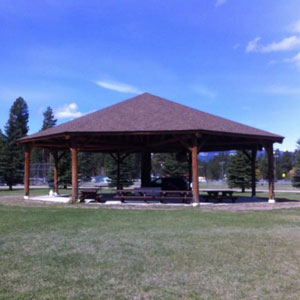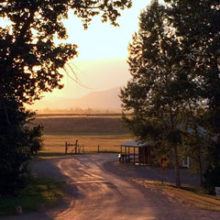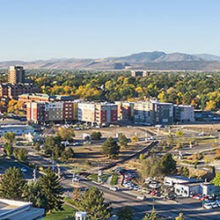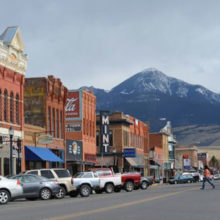- Lincoln, like many small towns across Montana and the West, faces economic difficulties as it grapples with the aftermath of long-term declines in traditional industries such as forestry and wood products manufacturing.
- This report overviews Lincoln’s current demographic and economic standing, compares Lincoln to peer communities, and discusses the major economic trends facing rural western towns.
- Informed by interviews and public meetings with many Lincoln residents, the report suggests a number of options within different time frames for citizens to consider and potentially pursue to enhance local economic development.
Background: Lincoln at a Crossroads
This report, informed by interviews and public meetings with many Lincoln residents, outlines a number of ways to pursue local economic development.
 Lincoln, Montana is a town of roughly 900 nestled amid incredible scenic beauty and located within a 90-minute drive to three major Montana cities: Helena, Missoula, and Great Falls. In many ways, Lincoln is emblematic of Montana’s earlier economic traditions: a rugged, outdoors-oriented small town with a multi-generational history of logging, mining, and agriculture.
Lincoln, Montana is a town of roughly 900 nestled amid incredible scenic beauty and located within a 90-minute drive to three major Montana cities: Helena, Missoula, and Great Falls. In many ways, Lincoln is emblematic of Montana’s earlier economic traditions: a rugged, outdoors-oriented small town with a multi-generational history of logging, mining, and agriculture.
Today, however, like many rural towns across Montana and the West, Lincoln faces economic difficulties. It is by no means alone in doing so. Rural western communities are grappling with the aftermath of long-term declines in traditional industries such as forestry and wood products manufacturing, and wrestling with how to compete in the sectors of the regional and national economy that are growing.
Many of the current trends facing Lincoln—such as its shrinking population and rising median age—cannot be sustained. Reversing these trends will take time, prioritization, and effort—especially for small towns like Lincoln that have limited resources, capacity, and volunteer time.
 Fortunately, Lincoln possesses resources that suggest the possibility of a brighter economic future: a local population is dedicated to the community and place, an attractive landscape, a major Montana highway and high traffic volume, stable K-12 education, a finalized Forest Service Travel Plan, the strong roots of cultural tourism, and an overall high quality of life.
Fortunately, Lincoln possesses resources that suggest the possibility of a brighter economic future: a local population is dedicated to the community and place, an attractive landscape, a major Montana highway and high traffic volume, stable K-12 education, a finalized Forest Service Travel Plan, the strong roots of cultural tourism, and an overall high quality of life.
Headwaters Economics cares deeply about the future of rural Montana and the West. Headwaters Economics has worked with the Blackfoot Challenge, participated in numerous local meetings, and looks forward to continued engagement with Lincoln and its residents.
Rural Economic Development and Lincoln’s Opportunities
The report overviews Lincoln’s current demographic and economic situation, compares Lincoln to several peer communities, and discusses the major economic trends facing rural western towns.
The study then turns to the challenges and strengths Lincoln possesses in the context of local economic development. This is followed by sections suggesting potential development options within different time frames—immediate-, short-, and long-term—for citizens to consider and potentially enact as steps toward an economic development plan for Lincoln. To help enable local efforts, this report also includes a list of possible grants and resources for Lincoln to pursue to help facilitate its economic development.
While Lincoln’s difficulties are significant, the town has many of the resources—whether access to cities or incredible natural amenities—needed to spur desired economic development. As a starting point, Lincoln has the opportunity to greatly improve its branding and identity across Montana and the West to attract tourists, spending, businesses, and jobs.
First, the town’s setting, K-12 school, and many other factors give Lincoln a small-town atmosphere and charm that is attractive to many tourists, repeat visitors, and people who may settle there. In addition, Lincoln already has many well-established tourism draws such as the Continental Divide Trail for hikers and bikers and many summer events and festivals.
Second, while Lincoln currently may wish that it captured more of the existing traffic on Highway 200, the traffic volume most certainly will continue and presents an enduring opportunity. In addition, the 90-minute-or-less driving time to three of Montana’s larger cities creates opportunities on several fronts, whether to improve access to the cities for workers and businesses now in Lincoln, to induce businesses to locate in Lincoln, or to increase tourism and other spending in Lincoln by residents from these nearby metro centers.
The third clear advantage for Lincoln is the region’s spectacular landscape and wide array of public lands, trails and users. The recent completion of the Forest Service Travel Plan, for example, provides certainty to both local businesses and tourists— offering 20-year planning window for local entrepreneurs to plan and invest in how best to promote Lincoln and its outdoor recreation opportunities.
Today, Lincoln’s abundant federal lands continue to provide natural resources for commodity sectors, but also offer recreational opportunities, natural amenities, and scenic backgrounds that stimulate migration, drawing entrepreneurs and attracting a skilled workforce across a range of industries. High-performing communities with nearby federal land generally have capitalized on this asset in multiple ways.
The Forest Service also has been a willing and involved partner, whether coordinating with local businesses to facilitate wildfire suppression spending, initiating restoration activities, or working with Lincoln’s sculpture park on hosting events.
Lincoln also has a number of areas where it can grow. The Sculpture in the Wild, artists in residence programs, and educational tours, for example, have made Lincoln a destination in ways that did not exist just several years ago. Furthermore, growing efforts to promote the recent addition of public river access will help improve and diversify the town’s ability to attract tourists, business visitors, and potential new residents.
Finally, Lincoln has an opportunity to attract people, businesses, or retirees who often are looking for safe, high-quality communities and landscapes. Appealing to retirees, for example, could help attract health care or other services, and their additional spending would circulate in the community and impact a number of sectors.



